Introduction to Nintendo Switch 2
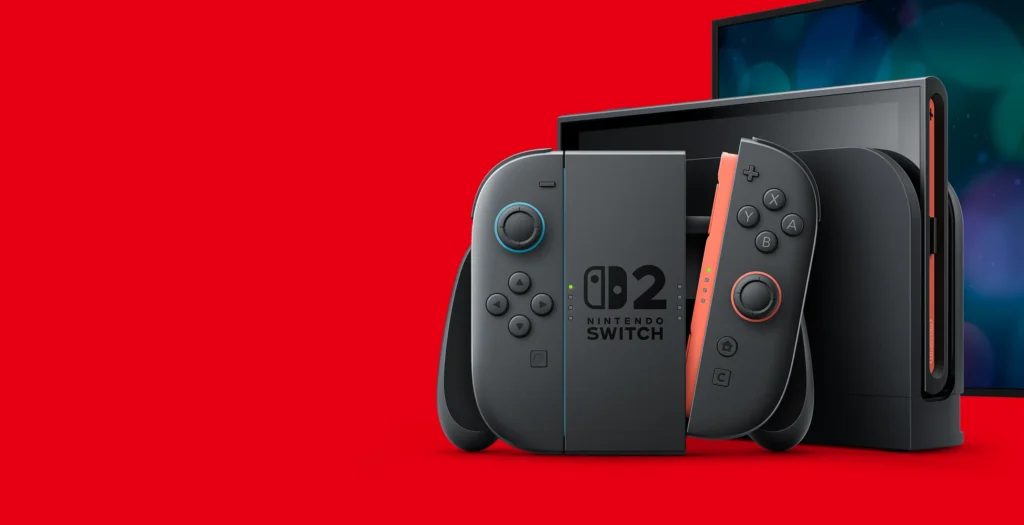
What is Nintendo Switch 2?
The Nintendo Switch 2 is not a refresh, but rather the next step in Nintendo’s lineage of hybrid consoles. Building on the incredible success of its predecessor, the new console promises to deliver high-performance hardware, 4K output when docked, and a better, smoothed-out experience for portable gaming. It’s not for nostalgia enthusiasts alone or casual gamers, either—Nintendo is building a machine that will compete in the high-powered console market of today without sacrificing its soul.
The Switch 2 needs to have the hybrid goodness we all adore: dock it for home gaming or use it on the move. But the improvements need to tackle longstanding user demands—quicker loading times, less lag, improved Joy-Con drift prevention, and even a new UI altogether. It’s Nintendo’s response to gamers’ growing pressure after witnessing what Sony and Microsoft have done with the PS5 and Xbox Series X.
Nintendo hasn’t officially announced the final design and specs yet, but rumors from trusted sources—developers, chipmakers, and insider writers—indicate a behemoth of a machine designed with the future in mind. And it’s doing it with backward compatibility in mind, so you won’t be abandoning your existing Switch library.
This console is no rumor; it’s an industry expectation. Dev kits are already being announced to developers. Retailers are preparing to take pre-orders. It’s no longer an “if” situation—it’s a “when.”.
Why It’s One of the Most Hyped Consoles

What is pushing the Nintendo Switch 2 to popularity? Let’s begin with how well the first one performed. The original Switch was not only successful—it was revolutionary. With over 120 million units sold worldwide, it showed that there is a huge appetite for hybrid gaming. Players adore convenience, and Nintendo took advantage of it.
Now that we’re entering a new generation of gaming, players are hungry for more. They need better performance, better graphics, faster online services, and better gameplay—and that’s just what the Switch 2 promises. All the leaked information points to a console that is not just an upgrade, but a redo.
From docking with 4K support, to a more powerful CPU/GPU combination, to built-in DLSS for graphics upscaling—this is going to be the most technologically sophisticated Nintendo console to date. Rumors are also in the air about improved multiplayer capabilities, a revamped eShop, and cloud gaming integration.
And then there’s the gaming community itself. Social media is abuzz. Forums are aflame. Reddit threads, YouTube leaks, Twitter tipsters—they’re all racing for the next hint. And the community isn’t sitting idly by; they’re invested. I mean, Nintendo games are not just products—they’re cultural touchstones. A new Mario, a new Zelda, or even Metroid Prime 4 on a new console? That’s gold.
The hype has nothing to do with hardware or specs. It’s about being able to carry on the magic of Nintendo but with a new and modern spin. That emotional connection, and improved tech, makes the Switch 2 one of the most hyped consoles ever.
History of the Nintendo Switch
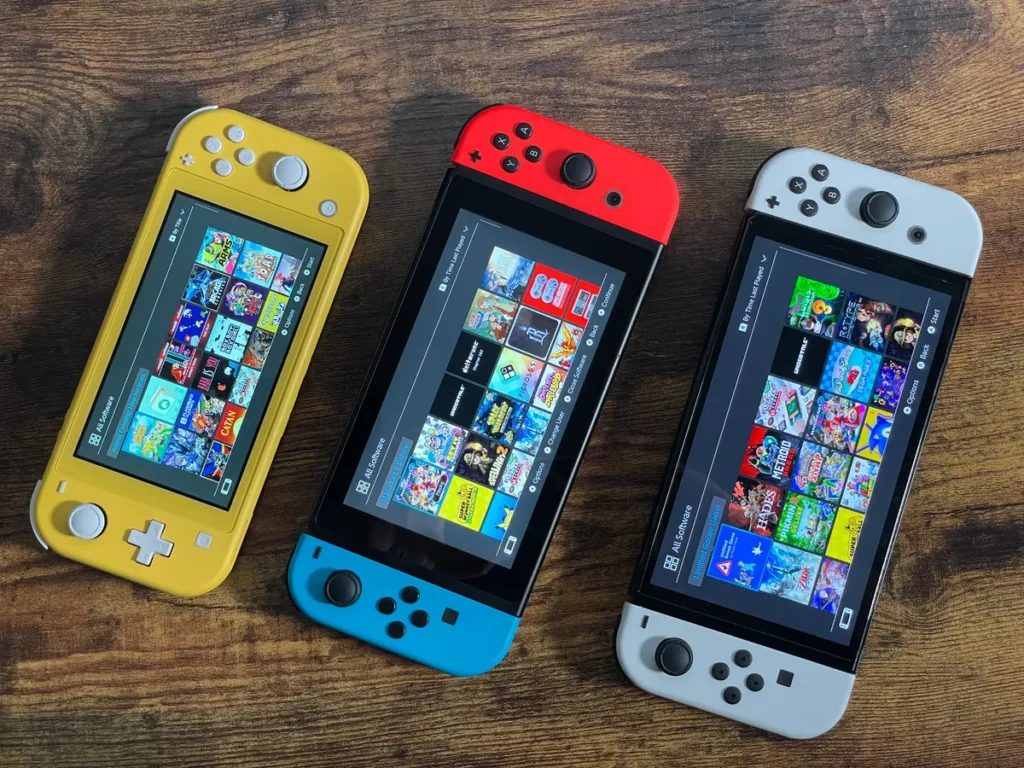
Success Story behind the Original Nintendo Switch
When the Nintendo Switch launched in March of 2017, the gaming universe was turned upside down in a single night. Following the commercial failure of the Wii U, Nintendo needed to emerge victorious—and they did. The Switch combined the best of both worlds: home console and portability. It was the first console to provide you with complete freedom on where and how to play your favorite games.
From the very beginning, Nintendo dropped game-changers like “Breath of the Wild” and “Super Mario Odyssey,” and they instantly put the console on the map. They weren’t games—they were game-changers that showed the world what the Switch was truly capable of. And the public listened. Sales went through the roof. By 2024, more than 120 million Switches were sold, making it Nintendo’s best-selling console to date.
Its popularity wasn’t as much about the hardware or the games as it was about the people. They played with others around them in parks, on airplanes, at parties. It wasn’t a game console; it was a social one. Nintendo also became wise by embracing third-party support and independent developers, which expanded the Switch’s game library exponentially.
The message was straightforward: play where you want, when you want, with whom you want. Freedom of that sort was the recipe for success. It wasn’t competing with PS5 or Xbox on graphics—it was competing with them on joy, and it won.
Nintendo Switch Lite and OLED Model Overview
With the success of the first, Nintendo expanded the family in 2019 with the Switch Lite. It was a smaller, lower-priced, handheld-only console for gamers who didn’t care about docking into a TV. It was lightweight, kid-friendly, and perfect for travel. It lacked removable Joy-Cons and motion control, but it included everything else—at a lower price.
In 2021, Nintendo launched the OLED Model, which didn’t boost performance but gave a far superior experience to those playing handheld. A stunning 7-inch OLED screen with deeper blacks and deeper colors made a huge difference. It also featured better sound, a fresh kickstand, and better dock capabilities. For many, it was the perfect way to play Switch on the go.
Nevertheless, both models utilized the same basic processor and memory as the original. That left game players eager for more muscle—something that could play more substantial, better games. That brought about the increasing buzz for the Switch 2.
Leaked Features and Specifications of Nintendo Switch 2
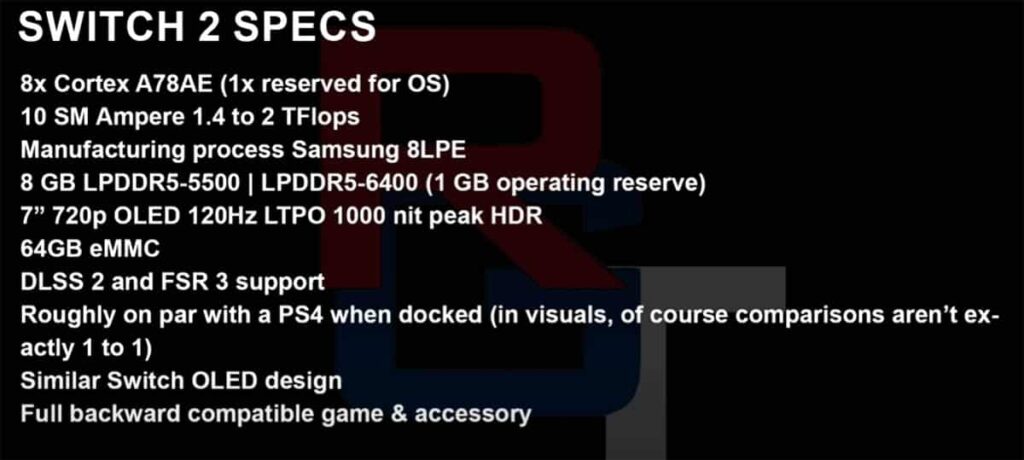
Display and Graphics Enhancements
The visuals are where it gets interesting. According to leaks and insider rumors, the Nintendo Switch 2 will be shipped with a 1080p screen in portable mode and 4K when docked, thanks to Nvidia’s DLSS (Deep Learning Super Sampling) technology. A far cry from the 720p screen of its predecessor.
But resolution is only half of it. Look for increased refresh rates—perhaps as high as 120Hz for even smoother gaming—and an improved panel period. OLED or Mini LED, you’ll get more intense color, richer blacks, and crisper details. It’s all about immersion, and Nintendo is well aware that today’s gamers demand a certain visual bar.
There is also speculation regarding bigger screen real estate, potentially reaching 8 inches, with reduced bezels to provide the most viewing space. This would further enhance handheld gaming to be even more immersive and cinematic.
The twist? DLSS will allow the console to “simulate” being 4K using less rendering horsepower, so large games can look incredible without burning the battery or heating up the system. That’s clever engineering—and very Nintendo.
Heightened Processing Capacity and RAM
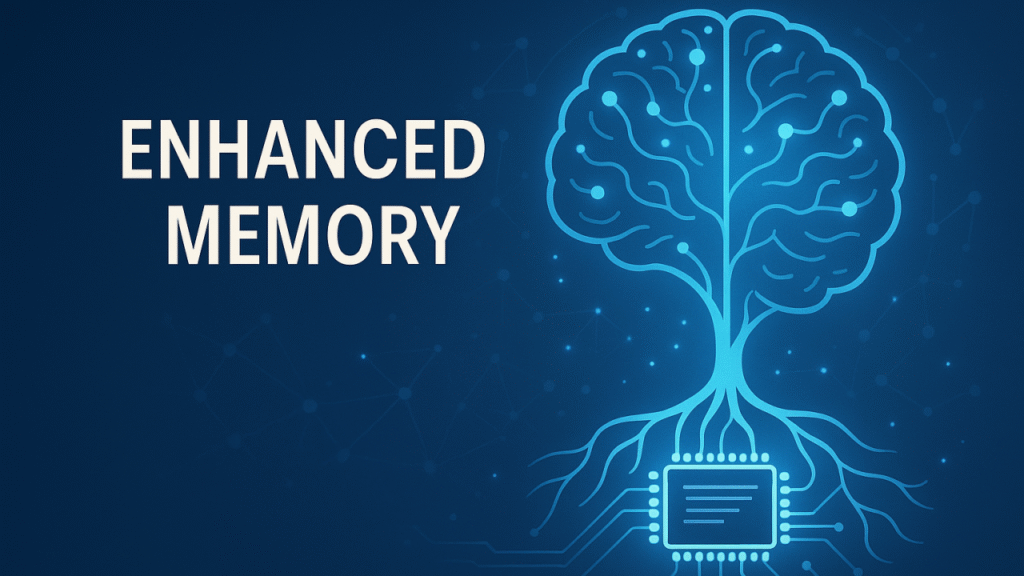
From a performance perspective, the Switch 2 is said to have a custom Nvidia chip that is much larger than its predecessor. Its new SoC is built using newer architecture, most probably Ampere or even Lovelace, that enables it to easily process modern game engines.
We’re discussing quicker load times, no lag, more responsive gameplay, and the ability for much more ambitious titles. Add on at least 8 to 12 GB of RAM, and you’re discussing a machine that can play AAA titles without flinching. That translates to improved physics, quicker AI rendering, and even multi-tasking amongst programs and games.
Game developers are already said to be coding with dev kits, so the hardware is close to production level. Good news for launch-day support and future-proofing the device.
Moving to the following sections in the outline:
Design Adjustments Expected
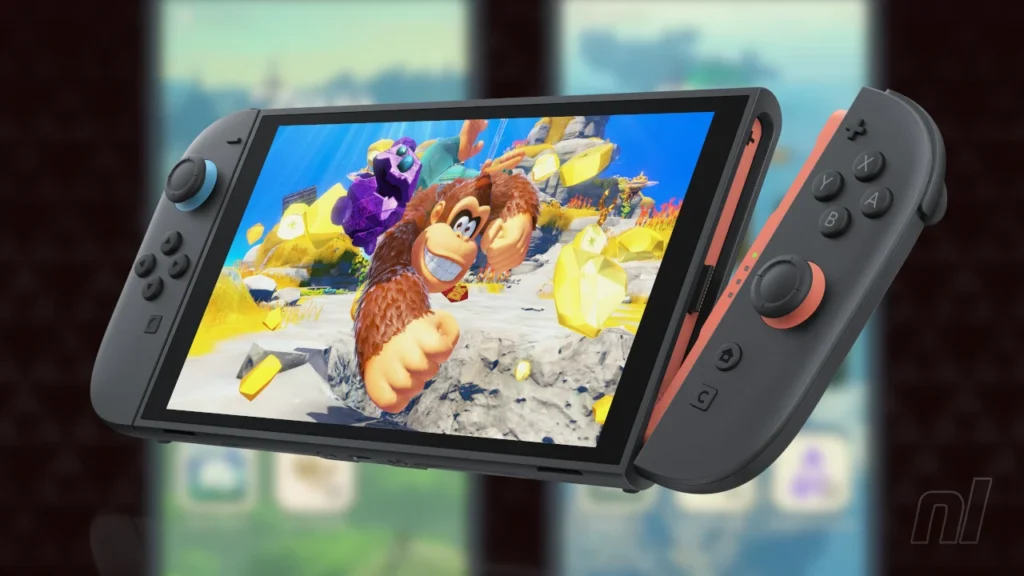
Sleeker, Modern Aesthetic
Nintendo hardware has never looked quite like anything else, from the quirky N64 to the minimalist Wii and the impossibly portable DS line. With the Nintendo Switch 2, the community is expecting something that screams modern without compromising the playful vibe that defines Nintendo’s hardware. Based on multiple leaks and conjectural renders, the next-gen Switch could feature a sleeker, thinner, and angular look that’s premium in the hand.
While the first Switch was somewhat chunky-looking, the Switch 2 might become thinner because of improvements in component design inside. Thin bezels are strongly possible, allowing a larger screen without making the overall device larger. That would improve the sense of handheld gaming, without compromising portability.
We could also expect improved materials. While the original was largely matte plastic, the new generation model could be aluminum or magnesium alloy-built, like today’s smartphones and tablets. That would provide increased strength and a more upmarket appearance. There needs to be a redesign kickstand—something more akin to the hinge on a laptop rather than the breakable tab on the original model.
Color choices can also receive an update. Nintendo’s fans are aware, and vibrant, personalized colors have been a part of its appeal. We might see limited edition versions, transparent shells, and theme editions for big-game releases such as a Zelda or Mario edition.
Nintendo can also take the opportunity to address significant ergonomic requirements. Long-time critics have lamented the Switch’s flat and uncomfortable grips for extended handheld use. A more contoured body with better hand support could finally solve this. Better heat dissipation vents, speaker positioning, and USB-C placement will also help smooth the user experience.
Eventually, the Switch 2 won’t be going all-out futuristic like the PS5. Rather, you can look for something sleek, cozy, and immediately familiar—a design that pays homage to the original but improves upon it in all respects.
Joy-Con Innovations and Controller Enhancements
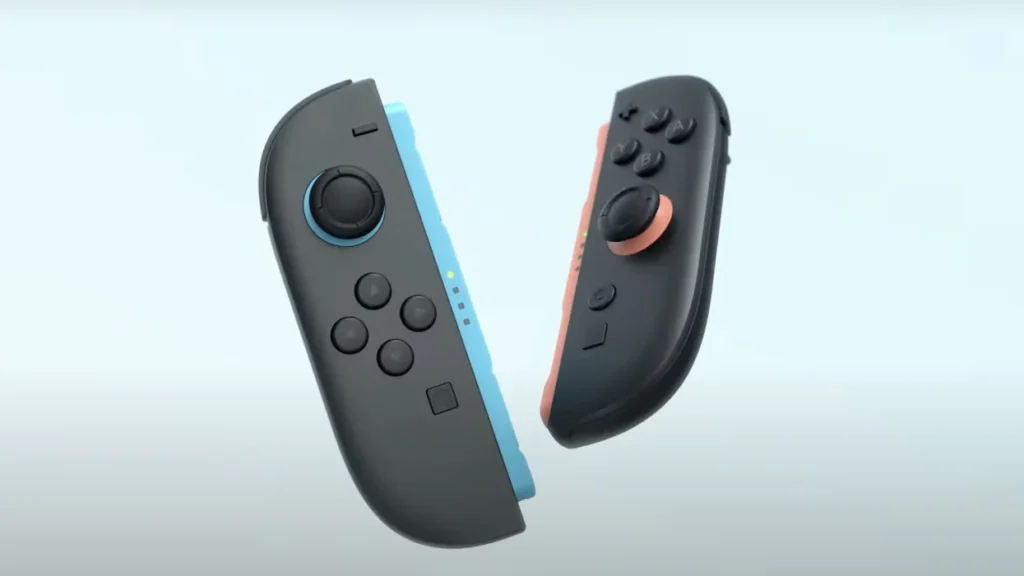
The Joy-Con are iconic—but let’s be real, they’ve had some problems. From drift issues to tight button design, there’s plenty of room for growth. Fortunately, the Nintendo Switch 2 appears to be bringing a long-overdue Joy-Con redesign.
First and foremost, Joy-Con drift—perhaps the longest-running issue with the original controllers—must be rectified. Rumors have it that Nintendo is working on a new joystick mechanism, possibly with Hall Effect sensors, which minimize physical contact and therefore wear and tear. That in itself could be a massive selling point for old-time fans.
There’s also speculation that magnetic attachment might replace the current rail system. Not just would it be easier to slide Joy-Cons on and off but also reduce mechanical wear and repair, making it easier to repair. Rumors even speculate the Joy-Cons may be slightly bigger and more hand-friendly in size to fit comfortably in adult hands.
Expect button redesigns as well. Nintendo could build upon the shoulder triggers, include improved D-pads, and modulate the vibration feedback to provide more precise haptic feedback. That is, a nicer feeling for everything from racing games to rhythm titles.
Wireless connectivity also requires an upgrade. Bluetooth 5.2 or higher would offer quicker syncing, reduced latency, and support for multiple controllers for couch co-op gaming. And, of course, rumors of built-in microphones and improved motion tracking for VR and fitness games.
Battery life may be extended as well. The existing Joy-Cons manage around 20 hours, but a fresh power-saving design combined with new batteries may take it even higher—possibly even 30+ hours on a single charge.
And if Nintendo really wants to innovate, there’s room for modular customization. Imagine changing analog sticks for a trackpad, or rearranging button configurations depending on the game. It’s a pipe dream, but if anybody can get away with funky innovation, it’s Nintendo.
All signs point to it being an improved, more robust controller experience that fixes issues of the past while offering a pathway for new gameplay possibilities.
Nintendo Switch 2 Games and Launch Titles
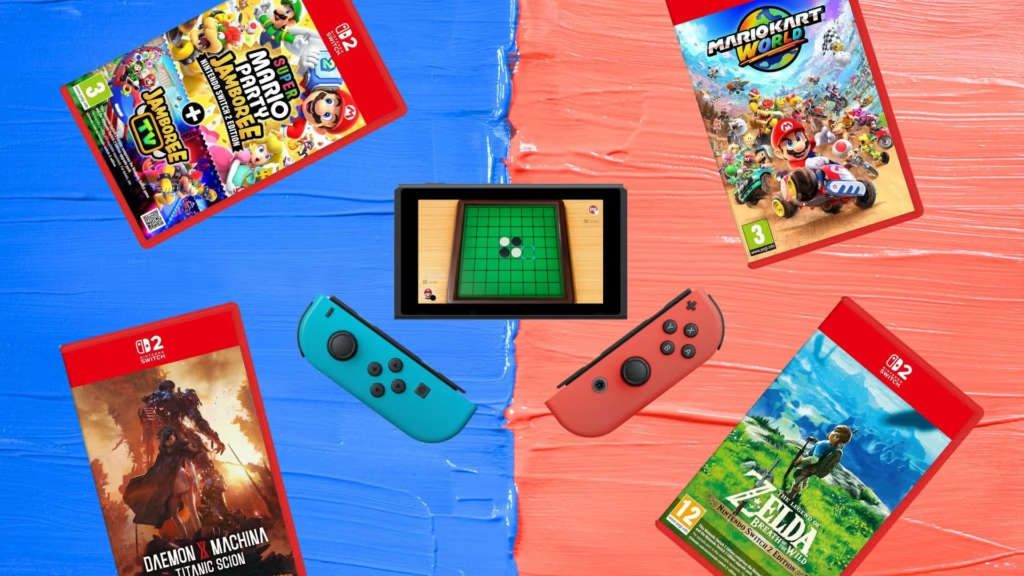
Confirmed and Leaked Titles
Arguably, no new console release is without the titles to support it. With the Nintendo Switch 2, however, expectations are high. With so many iconic franchises on hand, Nintendo can make or break its next-gen release on the first wave alone.
While Nintendo has not announced the launch titles, several credible leaks and developer rumors indicate a pair of prominent titles. Most frequently cited is a next-generation Pokémon game, built to fully exploit the capabilities of the Switch 2 hardware. This might be a reboot or a new open-world Pokémon game in the vein of “Legends: Arceus” with real-time combat and dynamic weather.
Another highly speculated game is a new Super Mario 3D platformer, possibly a sequel to “Odyssey” or a completely new journey. With the success of “The Super Mario Bros. Movie,” Nintendo has even greater motivation to surf on the wave with a giant launch title. And then there’s Metroid Prime 4, a game that’s been in development for years. It’s rumored that it was delayed just to release alongside the Switch 2, so it could play at its best with improved graphics, loading screens, and overall polish. We may even receive a Zelda remaster bundle (such as “Wind Waker” and “Twilight Princess”), or a completely new game teased following “Tears of the Kingdom.” Nintendo’s had a history of surprises, and a launch day stealth drop may cause some waves. Third-party developers are also said to be prepared. Companies such as Ubisoft, Square Enix, and Bandai Namco are said to be developing Switch 2 exclusives and ports. Expect games such as “Final Fantasy VII Remake” or “Resident Evil 4 Remake” to find their way on to the platform on day one or soon enough. Overall, the Switch 2 is hoping to ship with some seriously impressive library of games that could fill headlines and gamer wishlists for months on end.